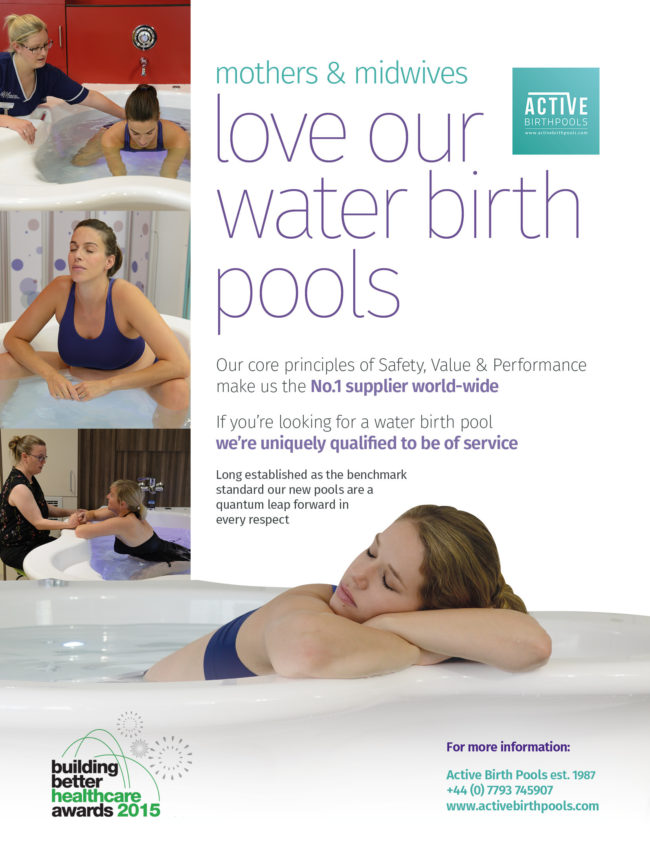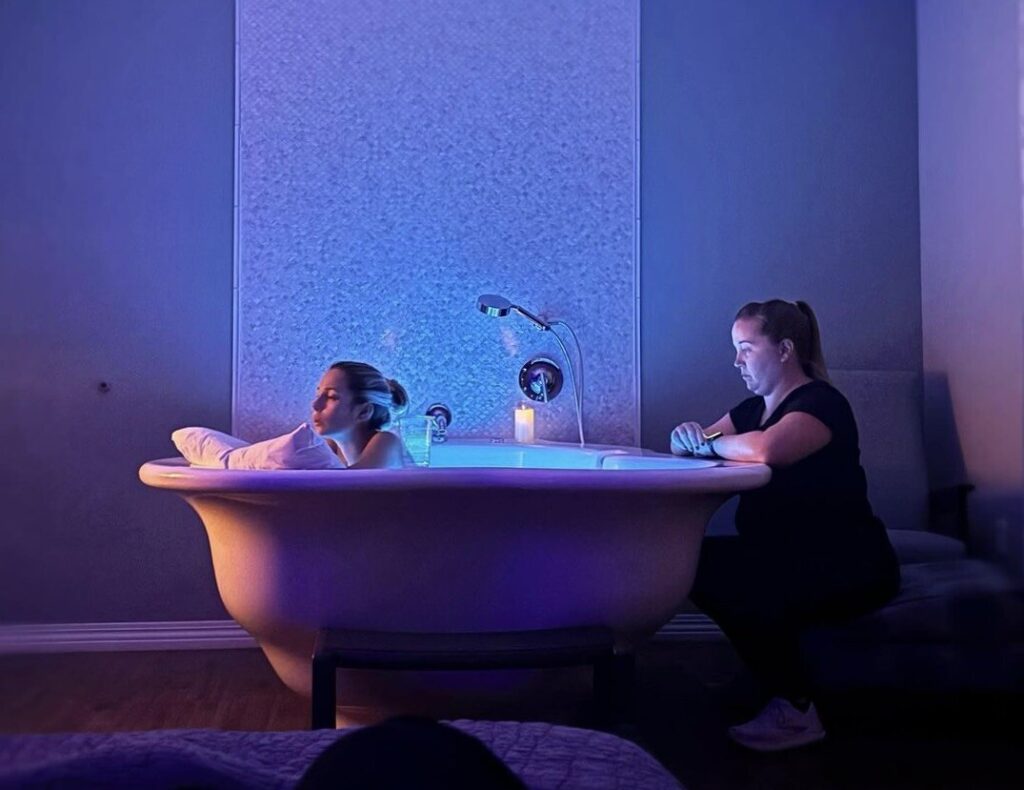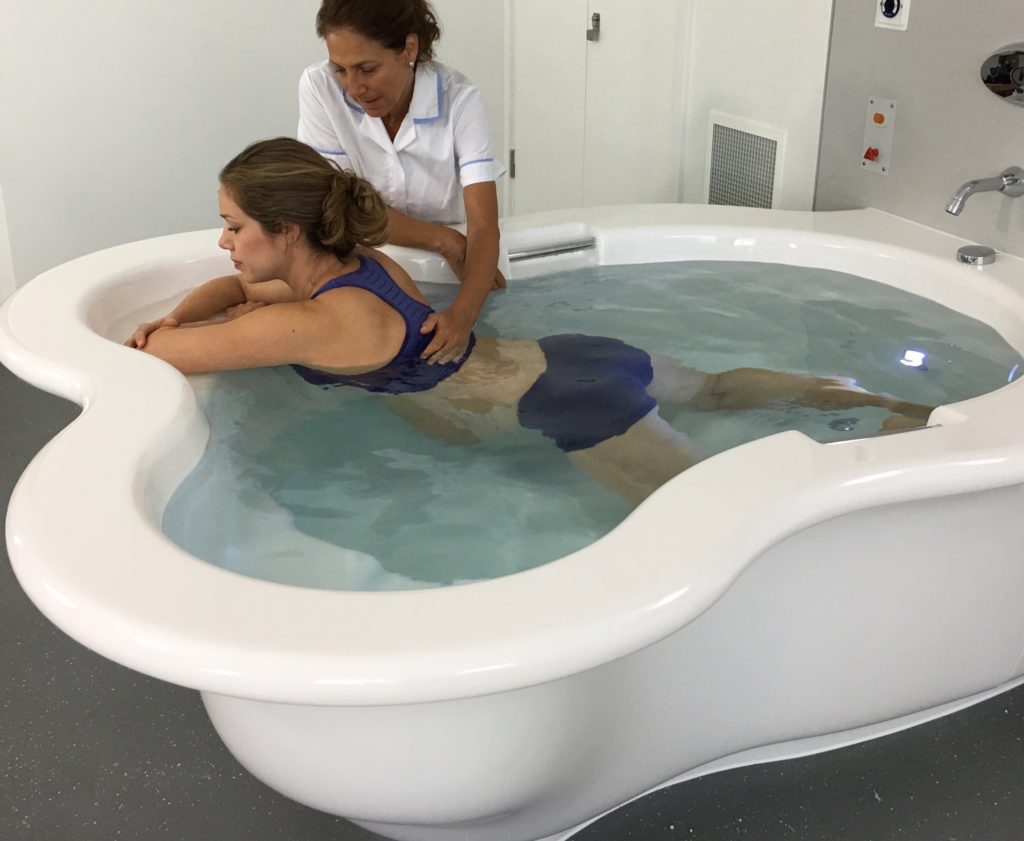Maggie Banks – RM, PhD, ADN, RGON
The paucity of literature on labour and birth in water with breech- presenting babies highlights a need to share (and document) empirical knowledge on the subject to piece together women’s and midwives’ growing experiences.
I was asked recently if leaving a woman in a birth pool to give birth to a breech presenting baby, undiagnosed until on the perineum, was ‘reasonable’ midwifery practice.
The question was qualified in that if the breech baby had been known prior to labour, the birth would definitely not have occurred in water as it is contraindicated in all the waterbirth guidelines in New Zealand.
My initial reaction, though fleeting, was to shrink away and not own my own experiences, knowing that these would be viewed as ‘unreasonable’ given that guidelines were presented as a self-evident truth that could not be argued with, that is, a known breech baby would not be born in water.
The issue of breech presentation and waterbirth is one that I have repeatedly explored in the midwifery and obstetric literature over the years and have found little written on the subject.
What is there usually cites the same source – Herman Ponette, the Belgium obstetrician in Ostend who actively promotes waterbirth with breech babies.1 There is minimal acknowledgement that it occurs in hospitals in the USA and the UK.2, 3
A Google search using the term ‘breech waterbirth’ brings up a handful of consumer stories and the occasional midwifery website which discusses the issue. Of the numerous stories I receive from women and midwives about breech birth, increasingly they involve the use of water.
This article pieces together some knowledge gained from reading, discussions, several of my experiences of, and reflections on, the use of water immersion with breech babies.
Going with the Flow
Initially I had been mindful of Michel Odent’s recommendation of not using deep warm water during breech labour as he warns that the soothing effect of water may mask an unduly painful labour, thereby preventing early detection of what may prove to be a problematic birth.4
My own first experience of using water in a breech labour happened by accident in that the frank breech baby remained undiagnosed until on the perineum. The woman had used the pool unconventionally in labour – she chose to lounge in the pool between contractions and stood during them. Once the breech was diagnosed I asked her to leave the pool and she stood to give birth.
This made me re-look at Michel’s caution. My experience of waterbirth with cephalic presentation had shown me that water immersion only mellows out normal labour pain, not severe or pathological pain, which would indicate the bone on bone painof true disproportion between pelvis and presenting part.
I had to question why this should be any different for a breech presenting baby – and I could not find an answer.
With the same woman’s second frank breech baby, this time diagnosed in pregnancy, she again used the pool unconventionally to relax between her contractions, and she birthed standing on dry land.
These two experiences marked a small shift in the use of water during my attendance at breech labour and birth in that water immersion remained available with a known breech. However, I continued to arrange with women that they would leave the pool for birthing.
This request changed following the birth of Heath, a firstborn presenting as a flexed legs breech. His mother had been deeply relaxed in the pool, assuming a wide open kneeling position leaning over the edge of the pool.
When the baby was visible on the perineum and the urge to push was overwhelming I asked the woman to leave the pool as we had prearranged, which she did.
Whereas she had been strong, independently held her own weight, and was powerful in her pushing, once out of the pool, she needed physical support to be in active birth positions and was unable to relax deeply between contractions as she had previously done in the pool.
The baby was born within half an hour of pushing and all was well but it was clear to me that I had intervened in a physiological birth and this had altered the ease with which the woman gave birth.
This birth occurred some months after the 1st International Waterbirth Conference in 1995.
Publication of Paul Johnson’s classic article 5 on the mechanisms that prevent or, conversely, stimulate breathing in the unborn baby during waterbirth would occur the following year but, in concluding his conference write up, Johnson, a Consultant Clinical Physiologist in the O&G Department at the John Radcliffe Hospital in Oxford, wrote:
“…if the onset of labour is spontaneous, and no drugs are administered, a fetus born with its cord intact, into warm, fresh water, not asphyxiated, is inhibited from breathing”6 – a process not dependant on presentation.
Initiation of breathing following waterbirth occurs once the baby surfaces and is exposed to cooler, dryer air and clamping the umbilical cord 6 – again, irrespective of presentation.
Sheila Kitzinger would report his additional comment that “if water births are of psychological and physiological benefit, it is logical that this benefit should apply to high-risk women too”.7
I knew deep water immersion to be a very powerful modality for achieving a relaxed state for the woman, enhancing vasodilation and placental perfusion and, therefore, oxygenation, of the tissues and organs, including the placenta during the normally stressing (not distressing) time of labour.
I had seen women become oblivious to everyone and everything as they sank into the pool. I had come to recognise the depth of sigh on entering the pool that signalled release of pain, fear, social etiquette and conversation – and these observations were irrespective of whether the baby was coming head or bottom first.
The Buoyancy and Warmth of Water
Another dimension was added when I attended a woman with twins, the second baby being a breech presentation. The woman had grown her babies well and began labour spontaneously at 40 weeks.
Due to the heaviness of her abdomen, she was drawn to labouring in water – her bath at home then, when labour was well established and she had travelled to her chosen birth place, the spa bath in the obstetric hospital.
There was a point in her labour where she needed to be more upright than reclining in the spa bath allowed, so we set up my free standing birth pool for her.
With the water up to the level of her breasts she became almost weightless in the pool, and was able to assume her intuitive positioning in a deep squat for the births of both her babies, the second of which had remained breech.
The woman reflected how supportive the water had been and how the upright position engaged her strength and ability to birth well.
Controlling Pelvic Pressure
When vaginal breech birth was a common occurrence 15 years or so ago, epidural anaesthesia was commonly recommended to overcome a premature urge to push. However, discussion with midwifery colleagues indicates a premature urge to push with a term breech baby is rare in woman-controlled positioning.
One woman who did experience significant pelvic pressure from the onset of labour with spontaneous rupture of membranes while having her first baby – a frank breech presentation – provided a piece to the mosaic of the use of water.
She controlled the urge to push by long and slow breathes during contractions and lying on her side on a floor mattress for most of her labour, rising only to crawl to the toilet on her hands and knees. After 12 hours of this, the pressure was overwhelming, even when lying.
While her good progress was evident from the lengthening burgundy buttock crease and her birthing energy, it was not time to use that expulsive energy. A vaginal examination confirmed a thin rim of cervix remained.
While a hands and knees position reduced the pressure, it was not until she lounged in the pool on her abdomen that the pressure again became tolerable. The pool was invaluable for enabling her to resume breathing over the contractions for the next three hours.
In the last hour prior to the birth, the woman commenced her grunting expulsions. As this had not brought her baby to a visible position in that time, I asked her to stand for one contraction to test the power of this feeling.
Simply standing engaged the pelvic pressure enough to bring the baby to almost rumping with the first push.
The second surge saw the baby rumped and progress so the popliteal spaces (back of the knees) were visible. With the next, he was born to the ankles, then descended quickly to wear his ‘perineal hat’ and his head was gently released without perineal trauma. All of this occurred without a contraction as the women responded to the pelvic pressure.
Assessing the Baby
The New Zealand Guideline Group’s best practice evidence-based guideline on breech labour and birth acknowledges that the evidence does not support continuous electronic foetal heart rate (EFM) monitoring by cardiotocography over intermittent auscultation.8
This is because, just as for well women and their babies with no alerting factors, there are no significant differences in standard measures of newborn wellbeing (including cerebral palsy and infant mortality) with continuous EFM in labour for ‘high risk’ situations, which frank or flexed legs breech presentation at term is deemed to be by some.
Only beneficial for its association with a reduced incidence of neonatal seizures, continuous EFM is associated with increased maternal morbidity by way of the accompanying increase in Caesarean and operative birth rates.9
At any given point the midwife needs to know that the baby is coping well with labour by assessment of his movements10 and listening to his heart beat.
As with any other labour for well women and babies, listening can be easily acheived with a Pinard stethoscope (or handheld, waterproof doppler) during water immersion.
Essential Elements of Physiological Breech Birth
Midwives commonly reflect on how their practice changes with attending waterbirths of cephalic presenting babies to become more ‘hands-off ’ during birth.
Confident that the water frequently dissipates urges to explosively push, while also supporting the woman’s perineal tissues and the baby as he is born, the midwife is drawn to a non touch vigilant attendance. This ‘hands off ’ in the absence of problems is the ‘golden rule’ during breech birth.
Maternal effort is an important part of achieving a ‘hands-off ’, spontaneous birth. As with any birthing, the woman needs to be supported to choose positions of comfort in the water which enhance her power and strength – kneeling, squatting, hands and knees or reclining.
Whichever birth position is chosen, the midwife needs to position herself so she can see both the advancing baby and the umbilical cord, and be in a position to palpate the umbilical cord if necessary.
The midwife may need ‘hands on’ for the birth of the head but the support of the water usually ensures gentle and woman- controlled birth of the baby’s head. Due to the reduction in gravity and an accompanying reduction in an urge to push for the head, the woman may need to be reminded to release the baby’s head.
Midwives who regularly attend waterbirths with cephalic presentation frequently reflect that if there is a problem during birth, for example, shoulder dystocia, they will initially try to correct it in the pool.
This avoids delay while utilising the water’s buoyancy so the woman can move easily to adopt very wide open positions that are needed for manoeuvres.
While Pinotte1 notes a reduced need for routine manipulations of the breech baby with waterbirth, in the rare circumstance that a manoeuvre is needed – to bring down stuck arms11 and/or flex, cradle and scoop out the baby’s head12 – these could also initially be done in the pool, again, avoiding delay.
The woman, however, would be asked to get out of the pool if problems were not easily remedied.
The Ongoing Mosaic
For some maternity professionals the issue of vaginal breech birth is no longer worth considering in the wake of the Term Breech Trial13 despite concerns about its methodological flaws.14-17
For others it remains a planned option.18-22 There will, of course, always be undiagnosed breech babies in labour, irrespective of the degree of antenatal scrutiny.
While some consider undiagnosed breech an ‘obstetric emergency’, the manner in which a midwife facilitates a vaginal breech birth, first diagnosed when birth is imminent, is the sameas if it was diagnosed antenatally and a vaginal breech birth is planned, albeit the latter having obstetric backup available with the birth in an obstetric hospital.
The use of deep water immersion with mal-presentation (read: breech) is contraindicated in hospital clinical guidelines on waterbirth, and the use of water is absent as a modality in vaginal breech birth guidelines.
Embracing these, giving birth in water to a breech baby would be out of the question for some maternity providers.
Yet others are very specific in seeing breech presentation as a positive indication for waterbirth because of the buoyancy afforded to the baby and umbilical cord, both of which are kept warm in the water until surfacing into the cooler air,1,23,24 contraindicated only if the breech labour is not progressive and/ or is complicated.25
Midwifery can have additional knowledge fragments to obstetric knowledge, gained by our deep relationships with women.
Being attentive to women who are called to use water through breech labour and birth and walking side by side with them during this time has added to my understanding of facilitating physiological breech birth.
We need to be able to share the practice wisdom which comes from our experiences, discussions and reflections. We also need to be able to do this without fear of repercussions that may be activated from that disclosure. As a result, we will continue to find ongoing pieces to the mosaic of breech waterbirth.
References:
Ponette H. Breech and twin deliveries in the water. Accessed 20 March 2000. Available at http://www.helsinki. fi/~lauhakan/whale/waterbaby/p6.html
Kitzinger S. Sheila Kitzinger’s letter from England. Birth 1991;18(3):170–171.
Harper B. Waterbirth basics – from newborn breathing to hospital protocols. Midwifery Today 2000;54:9– 10,12–15,68.
Odent M. Birth reborn. Souvenir Press: New York, 1984:103–105.
Johnson P. Birth under water – to breathe or not to breathe. BJOG: An International Journal of Obstetrics and Gynaecology 1996;103(3):202–208.
Johnson P. Birth under water – to breathe or not to breathe. In, Lawrence Beech BA (ed).Water birth unplugged. Proceedings of the First International Water Birth Conference. Books for Midwives: Cheshire, England, 1996:31–33.
Kitzinger S. Sheila Kitzinger’s letter from England: is water birth dangerous? Birth 1995; 22(3):172–173.
New Zealand Guidelines Group. Care of women with breech presentation or previous Caesarean birth. New Zealand Guidelines Group: Wellington, 2004:xxi, 32.
Alfirevic Z, Devane D, Gyte GML. Continuous cardiotocography (CTG) as a form of electronic fetal monitoring (EFM) for fetal assessment during labour. Cochrane Database of Systematic Reviews 2006, Issue 3. Art. No.: CD006066. DOI: 10.1002/14651858. CD006066.
Banks M. Utilising the unborn baby’s in-labour movements. New Zealand College of Midwives Journal 2003;29:6.
Banks M. Breech birth woman-wise. Birthspirit: Hamilton, New Zealand, 1998:88–89.
Ibid., pp. 90–91.
Hannah M, Hannah WJ, Hewson SA, Hodnett ED, Saigal S, et al. Planned caesarean section versus planned vaginal birth for breech presentation at term: a randomised multicenter trial. Lancet 2000;356:1375–1383.
Glezerman M. Five years to the term breech trial: the rise and fall of a randomized controlled trial. American Journal of Obstetrics and Gynecology 2006;194(1):20–25.
Kotaska A. In the literature: combating coercion: breech birth, parturient choice, and the evolution of evidence-based maternity care. Birth 2007;34(2):176–180.
Keirse MJNC. Evidence-based childbirth only for breech babies? Birth 2002;29(1):55–59.
Goer H. When research is flawed: planned vaginal birth versus elective Cesarean for breech presentation. Accessed 14 August 2007. Available at http://www.lamaze.org/ Research/WhenResearchisFlawed/ VaginalBreechBirth/tabid/167/ Default.aspx
Goffinet F, Carayol M, Foidart J, Alexander S, Uzan S, et al. Is planned vaginal delivery for breech presentation at term still an option? Results of an observational prospective survey in France and Belgium. American Journal of Obstetrics and Gynecology 2006;194(4):1002–1011.
Hellsten C, Lindqvist PG, Olofsson P. Vaginal breech delivery: is it still an option? European Journal of Obstetrics & Gynecology and Reproductive Biology 2003;111(2):122–128.
Sibony O, Luton D, Oury J, Blot P. Six hundred and ten breech versus 12,405 cephalic deliveries at term: is there any difference in the neonatal outcome? European Journal of Obstetrics & Gynecology and Reproductive Biology 2003;107(2):140–144.
Giuliani A, Schöll WMJ, Basver A, Tamussino KF. Mode of delivery and outcome of 699 term singleton breech deliveries at a single centre. American Journal of Obstetrics and Gynecology 2002;187(6):1694–1698.
van Roosmalen J, Rosendaal F. There is still room for disagreement about vaginal delivery of breech infants at term. BJOG: An International Journal of Obstetrics and Gynaecology 2002;109(9):967–969.
Charkowsky I. In: Napierala S. Water birth: a midwife’s perspective. Bergin & Garvey: London, 1994:181–182.
Enning C. Personal communication, 2008.
Ponette H. The New Aquatic Maternity in Ostend. Accessed 20 March 2000. Available at http://www.helsinki. fi/~lauhakan/whale/waterbaby/p2.html










